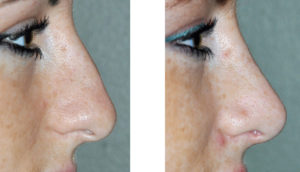Rhinoplasty, or nose-shaping surgery, is one of the most common plastic surgery procedures of the face. It can have a dramatic effect on one’s facial appearance due to the prominent position of the nose on the face. While rhinoplasty surgery has been performed for over 100 years, modern rhinoplasty techniques create noses that are more natural and can hold their shape over time.
Historically, rhinoplasty surgery was associated with after surgery appearances which were ‘overdone’. This type of reductive rhinoplasty produced noses that were short with up-turned tips(pugnose appearance) and with low bridges. Even if the nose did not appear this way immediately after surgery, this appearance developed months or years later. This nasal appearance was the result of removing too much of the natural structures of the nose. Taking the bridge of the nose down too low (bone and cartilage) or shortening the tip of the nose excessively (all cartilage), while immediately looking good, weakens the support of the nasal framework. Over time, as scar forms and tissues heal and contract, the nose gradually ‘falls’ and assumes an unnatural appearance. It may look too small, too upturned, or too narow and pinched at the tip.

Besides less cartilage and bone removal, the natural rhinoplasty makes use of adding support through cartilage grafts as necessary. Supporting the nasal tip through columellar strut grafts, small hand-carved grafts for better tip definition, spreader cartilage grafts to the middle vault to improve breathing, and adding height at the very top of the nose where it joins the forehead (radix) with small crushed cartilage grafts are some of the ways to help build and strengthen the framework of the nose. These cartilage grafts are usually acquired from the septum of the nose (which may be simultaneously straightened) or from the back of the ear.
Natural rhinoplasty techniques are a combination of preserving critical nasal tissues, skillfully rearranging the different zones of the nose, and the three-dimensional eye to visualize how to get to the final nasal result. It is usually best done through an ‘open approach’ with a resultant indetectable scar across the columella. (strip of skin between the nostrils) Natural noses fit each patient’s face more proportionately and never have that ‘operated’ appearance. While tedious to perform, I find the long-term results rewarding and the need for secondary revisional surgery reduced.
Dr Barry Eppley
Indianapolis, Indiana


